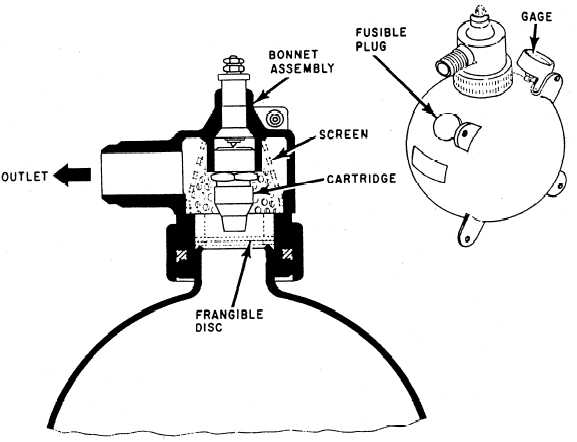engine nacelle. A screen in the bonnet (fig. 1-24)
prevents the segments of the shattered disc from
being expelled into the distributing assembly. The
CF3Br agent discharges from the distributing
assembly as a spray, which (in the presence of
heat) turns into a dense gas. This gas reduces the
oxygen supply content of the area and effectively
smothers the fire.
Container Assembly
Each container assembly (fig. 1-24) consists
of the following components: A fusible plug,
pressure gage, frangible disc, cartridge, bonnet,
and the container itself. The container is a
spherical assembly, designed to contain 6.5
pounds of CF3Br and a precharge of 600 psi of
nitrogen at (70°F).
NOTE: The capacity and precharge of the
container assembly will vary with the type of
installation.
Figure 1-24.—CF3Br container assembly.
The combined nitrogen charge and CF3Br is
retained in the container by the frangible disc and
the fusible plug. The fusible plug protects the
container from possible damage by excess pressure
caused by an increase in ambient temperature. The
metal of the fusible plug melts at temperatures
between 208° and 220°F, releasing the contents
of the container overboard.
Discharge Indicator
One discharge indicator is mounted on each
nacelle as shown in figure 1-23. The indicator
consists of a red disc and an aluminum alloy tube
that connects to the container at the fusible plug.
If thermal expansion in the container is great
enough to rupture the fusible disc, the red disc
will rupture and the CF3Br will flow overboard
through the line to the indicator. Therefore, when
the discharge indicator is missing, the container
must be checked for proper pressure.
Some CF3Br containers have a relief valve in
place of the fusible plug. On some, the fusible
1-33


